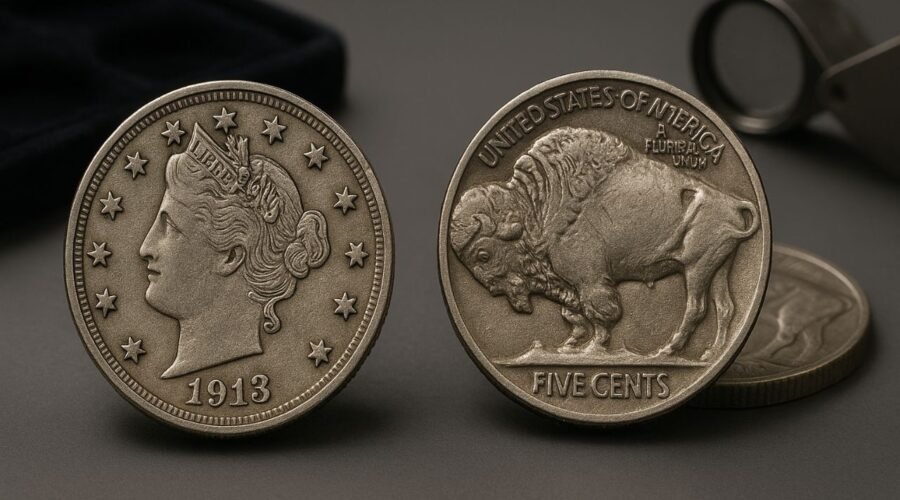1913 Liberty Nickel vs Buffalo Nickels- The Key Differences
The 1913 Liberty Head nickel is a five-coin legend worth millions, while Buffalo nickels (minted 1913–1938) are beloved circulation coins with famous key dates and varieties.
Knowing the differences helps you separate a museum-level rarity from collectible coins you can actually hunt for, grade, and sell.
Origin And Mintage
- 1913 Liberty Nickel: Only five pieces exist, struck under unusual, likely unauthorized circumstances at the Philadelphia Mint after the Liberty design officially ended. Their named pedigrees (Eliasberg, Walton, “Hawaii Five-O,” Norweb/Brand, Olson) drive intense demand.
- Buffalo Nickel (Indian Head): Designed by James Earle Fraser, struck 1913–1938, standard composition 75% copper / 25% nickel, weight 5.00 g, diameter ≈21.2 mm. In 1913 the series launched with Type 1 (bison on a raised mound) and quickly shifted to Type 2 (recessed FIVE CENTS) to reduce wear.
Market Reality And Records
- 1913 Liberty Nickel: Multiple public results confirm multi-million-dollar values (notably over $4 million for top specimens). Only three are in private hands; the other two are institutionally held or exhibited.
- Buffalo Nickels: A broad, affordable series overall, but with elite keys such as 1918/7-D overdate, 1916 doubled-die obverse, 1937-D Three-Legged, and 1913-S Type 2 (low mintage). Choice uncirculated examples of these keys can reach five- and even six-figure prices, while common dates remain accessible.
Design Differences You Can See
- Liberty Nickel (Barber): Classical Liberty head obverse; reverse with a large “V” (Roman numeral for five) inside a wreath. The 1913 pieces are typically prooflike and superbly preserved.
- Buffalo Nickel (Fraser): A composite Native American portrait on the obverse; an American bison on the reverse. Type 1 shows the bison on a mound; Type 2 places the bison on a flat base with recessed lettering to protect FIVE CENTS from friction.
Quick Comparison
| Attribute | 1913 Liberty Nickel | Buffalo Nickels (1913–1938) |
|---|---|---|
| Designer | Charles E. Barber | James Earle Fraser |
| Known Population | 5 coins total | Billions struck across dates/mints |
| Year Introduced | (Unofficial) 1913 | 1913 |
| Types/Varieties | Single prooflike issue | Type 1 (mound), Type 2 (recessed), major varieties incl. 1918/7-D, 1916 DDO, 1937-D 3-Legged |
| Composition | 75% Cu / 25% Ni | 75% Cu / 25% Ni |
| Weight / Diameter | 5.00 g / ≈21.2 mm | 5.00 g / ≈21.2 mm |
| Value Range | $4M+ per coin | Common dates: modest; key dates in high grade: $10,000–$100,000+ |
| Collectability | Trophy-grade, museum level | Broadly collectible; deep set-building potential |
Collecting Outlook In 2025
- Chasing A Legend (1913 Liberty): Realistically limited to museums and ultra-high-net-worth collectors. Authentic examples are pedigreed and carefully documented; any “new discovery” claim warrants expert authentication.
- Smart Targets (Buffalo Series):
- Hunt the 1918/7-D overdate and 1916 doubled-die—two of the hobby’s most dramatic varieties.
- Prioritize semi-keys like 1913-S Type 2 and low-mintage 1920s–1930s issues.
- Eye appeal matters: full horn detail on the bison and strong legends command premiums.
- Certified grading (e.g., MS65 and above) multiplies value on better dates.
How To Tell Type 1 From Type 2 Quickly
Flip to the reverse under the bison:
- Type 1: Raised mound with FIVE CENTS on the mound—prone to wear.
- Type 2: Flat base; FIVE CENTS is recessed to last longer in circulation.
The 1913 Liberty nickel is the mythic pinnacle of American numismatics—five coins, multi-million-dollar prices, and storied pedigrees.
By contrast, Buffalo nickels offer everyday collectors a rich world of history, design, and discovery, from the Type 1 vs. Type 2 change to famous varieties that can rival blue-chip coins in top grade.
If you want the best mix of heritage, hunt, and upside, build a focused Buffalo set and learn the diagnostics that separate common dates from true keys—while appreciating the 1913 Liberty as the once-in-a-generation trophy it is.
FAQs
Why Are Only Five 1913 Liberty Nickels Known?
They were produced outside normal mint channels after the Liberty design officially ended, leaving only five confirmed survivors with documented pedigrees.
What Are The Most Valuable Buffalo Nickels?
The 1918/7-D overdate, 1916 doubled-die obverse, 1937-D Three-Legged, and 1913-S Type 2 are perennial stars—especially in uncirculated condition.
How Do I Spot A Valuable Buffalo At A Glance?
Check the date and mintmark, look for strong details (full bison horn, sharp legends), and watch for notorious varieties; when in doubt, certify the coin to verify grade and authenticity.


Leave a Reply